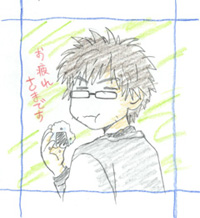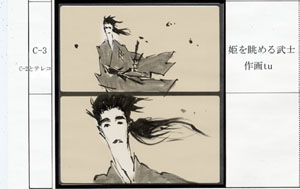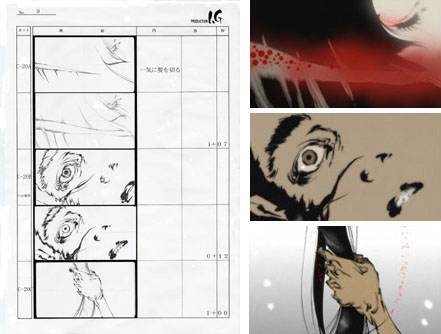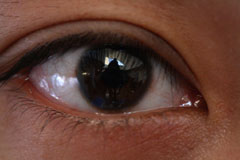The Making of Asience 1: Akihiko Suzuki (Production Manager)
Asience: Hairy Tale is one of those little jewels Production I.G is particularly proud of. In just 60 seconds, this animated short concentrates the creative effort for one full TV episode, crafted by theatrical feature-class staff, starting from director Kazuto Nakazawa (Kill Bill: Vol. 1 animation segment) and continuing with art director Shuichi Hirata (Innocence) and music composer Yoshihiro Ike (Blood: the Last Vampire). In this multi-part special feature, we interviewed the production staff from every section, in order to offer a wider perspective about how this animation was made. And for the first intalment, we talked with the production manager Akihiko Suzuki, the man who saw it all.
 | Akihiko Suzuki - Production manager. Born in 1981 in Nagasaki, Suzuki decided to pursue a career in the animation industry after watching Patlabor 2: The Movie and joined I.G in 2005. The first assignment was as a studio staff member in the TV series, Crayon Shin-chan. Later, he joined the in-betweens management section. |
First of all, for those who are not familiar with the animation production process, can you briefly describe your job as a production manager?
Simply put, it's ranked at the very bottom of staff positions starting from the director, designers, artists, etc. (lol) In short, I need to skillfully connect different staff members who are responsible for various jobs and also connect different sections in order to manage the production process so that it would progress smoothly. You need to be able to read and understand the storyboards, so that you would be capable of predicting the tricky sections beforehand. Lastly, we would try our best to reflect the director's thoughts in the work. Well, in reality, we habitually run around with a mobile phone in one hand and a bag full of drawings in another. (lol)
Did you join I.G because you wanted to work as a production manager?
When you look at people who come to anime studios for job interviews, they are either those who can draw or who can't draw. I couldn't draw, so I became a production manager. There is a path for a production desk manager to become an episode director and then a series, or movie, director, but that's only open to a very few selected people. Normally, if you work hard, you can become a line producer. That's where I'm aiming. I joined I.G in September 2005. Since then, I have worked on Crayon Shin-chan - about ten episodes altogether. Then I was transferred to a position responsible for in-betweens management in April last year. What I do is to get orders from in-house or outside studios and distribute them among the in-between animators here. And this January, I was able to land on the job to work on Asience.
There is quite a difference between Crayon Shin-chan and Asience in terms of atmosphere...
Quite a change! (lol)
Did you put your hand up to get the job?
Nope. Mitsumoto-san, the line producer, asked me, "Have you got time?" I answered, "I am not exactly free, but do you have a cool project?" His answer was, "It's a 60-second one for Nakazawa-san on a shampoo product." When I heard this, I instantly replied, "When do we start?" (lol) As I looked at the list of staff members, I knew they were putting a lot into this project, so I worked hard to bring out the best quality possible.

Surely you do not see such a group of talented staff enlisted for the same project everyday.
It was only possible because it was such a short project. And also I must point out that Producer Mitsumoto had the capability to invite these talented people in.
It is such a unique work. Was there anything different from your usual work as a production desk manager?
Everything! If I must pick one, then I should mention that the outlines were all done with brush-touch. This affected the in-betweeners the most. In a standard production, the key animator would draw the frames at the key points of the sequence, and the in-betweeners would fill the gap between each such key frame to create the movements. Normally, you have a simple line, that is easy to reproduce. But when you have irregular brushed lines, then you have to draw irregular brushed lines in the in-between drawings as well. Can you imagine that? It would probably not be totally impossible to do that with CG, but we knew they would certainly bring out more impression if they were drawn by hand one by one. As a consequence, it was the most difficult part in the production process.
Another unique point is that the director drew all the key frames. Initially, it was intended that Nakazawa-san would draw the storyboards and then have a couple of experienced animators draw the key frames. Then, Nakazawa-san would supervise and correct them to make the style homogeneous, in other words we expected him to act as animation director as well, and nothing more. That's the usual stuff. But then I received a phone call from Nakazawa-san and he said, "I will do all the key frames, too." You can see his commitment to this project. New key frames turned up every two to three days. The result was just overwhelming every single time. I was luckily positioned to see them first. That's the happy moment for a production manager.
Was there any cut that you as a production desk manager had a difficult time with?
I'd say cut 3 (NOTE: the Samurai approaching at the beginning), cut 5 (NOTE the track-back on the Samurai face after he sees the Princess) and cut 20B (NOTE: the Samurai falling down at the end), that require delicate camera movements such as track-up and track-back. This usually means hard work for the in-betweeners, as the movement was not rendered by simply zooming up the same drawing, but by actually drawing each single frame, calculating the shrinking or enlarging of the picture. And I should mention also cut 4, when the Princess turns her head: we had a lot of hair movement as well as the turning of the her head while coming close to the camera. The in-betweeners really had to imagine the movements in their head to draw. It must have been very hard. We asked skilled animators to work on these four cuts.

Is it your job as a production desk manager to assign in-betweeners?
Yes. Especially for this project, I chose five to ten of the most skillful in-betweeners from about thirty who usually work full-time at I.G. And the in-between checker, Junko Nishimura, is unyielding when it comes to checking the work, so she openly instructed me to recruit certain artists do the job.
Is there anything you learned from working with Nakazawa-san?
A lot! When the storyboards arrived, I truly appreciated being there. I could not believe how he could have created such thorough storyboards from those image boards submitted by the client. You do not usually draw storyboards to that level. The minimum requirements for storyboards are movements and facial expressions, but this time, they expressed the entire world of the project. You could see that he had an image to convey quite strongly.
And you know, there was not a single retake for the in-betweens and color finishes. There were about 1,700 drawings altogether. Nakazawa-san is famous for avoiding retakes, but I think it owes a lot to the superb talents of Nishimura-san who checked the in-betweens and the fifteen color painters who worked in digital paint section at I.G.
How is Nakazawa-san like at work?
He is very funny. And he is very kind to us staff, although he doesn't really show it openly. He is exactly opposite to what you'd call a "master." In a sense he is a sort of reckless person, but his likable character makes us forgive him. He must have had other projects to work on simultaneously as he worked on Asience, but he came to the studio almost every day to check the work in progress. We were very grateful for his commitment. Well, I was very fortunate to have worked with him in this project.
Which cut do you like the most?
I'd definitely say, cut 20B. To tell you the truth, they took a photo of my eye and used it in that cut. The director said, "I will deform it to the extreme that you wouldn't be able to guess the original!" Whatever, it's a debut occasion for my eyeball! (lol) Nakazawa-san can surely draw without referring to a photo, but he confided that he needed a realistic picture.

If you could have your hopes come true, what would you like to do?
I'd like to do a fun project that the staff would be happy to work on. In this project, the in-betweens and color finishes were quite challenging, but when we saw the finished film, everyone said they were happy to be part of the team. That's the best compliment.
(1 - to be continued)
© 1994-2007 KAO CORPORATION. All Rights Reserved.

![WORK LIST[DETAILS]](/contents/works/design/images/left_title.gif)



 terms of use
terms of use